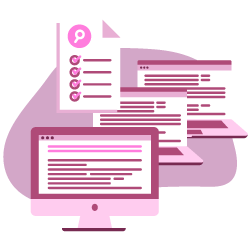Backlinks play an integral role in determining organic search rankings. Google’s search algorithm has become so complex and sophisticated with artificial intelligence that it’s possible even the Google engineers don’t know exactly how search rankings are calculated. However, studies continue to show a strong correlation between backlinks and organic search rankings.
So, it’s time to start promoting your pages for links, right? Well, not every page is designed to earn links and it’s possible that even your link-worthy pages are not ready for active link building.
Explaining the difference between link-worthy assets and non-linkable pages is its own post, but if you’ve already identified which pages are linkable then you can use this checklist to ensure there aren’t any technical issues holding your asset back before you start building links.
On-Page Optimization
Promoting pages that are not fully optimized is like building links with one arm tied behind your back. Not only will this affect conversion rates for your link outreach, but the value of any links you do secure will be diminished by suboptimal onpage factors.
First off, make sure your page is actually indexed by checking in Google Search Console or with Oncrawl — it won’t matter how many links you acquire if the page they point to isn’t indexed by search engines.
Next, you’ll want to revisit the page’s title as well as header tags to ensure they align with the keywords and phrases you are targeting. If you’ve uncovered new opportunities during keyword research, make the necessary changes to optimize your page for those opportunities before you start pursuing links — these simple changes could actually improve rankings before you secure your first link.
You should also take this time to review the structure of your page and how information is formatted. Does your format match the format of the pages that are currently ranking? Are there any SERP features you should consider optimizing for (rich snippets, image results, videos, etc.)?
For example, if you see a rich snippet on the results page, you should optimize for that snippet by providing a quick, direct answer to the query near the top of your page. If the current featured snippet consists of a bulleted list, you should consider reformatting your content into a bulleted list as well.
Links are critical to ranking in organic search, but they can only prop up poor or suboptimal pages for so long, and best practices dictate optimizing your pages before you start link acquisition.
[Case Study] Optimize links to improve pages with the greatest ROI
Improve User Experience
Another important step in this checklist is making improvements to user experience (UX). Again, improvements to UX will improve conversion rates for link outreach, as site owners will be much more likely to endorse a page to their audience (aka link) if that page provides an excellent experience.
One of the most common areas where improvements can be made is page speed. In our increasingly mobile and connected lives, we’ve become accustomed to getting answers and making decisions quickly. Visitors aren’t going to patiently wait for your page to load — they will leave and find a different page that loads quickly — and furthermore, webmasters won’t link to a slow-loading page.
So how do you improve page speed?
Fortunately, Google offers help in the form of PageSpeed Insights, a tool that will provide feedback on the speed of your page and offer suggestions for ways to improve it. These suggestions include:
- Minimizing render-blocking stylesheets
- Leveraging HTTP caching for repeat visitors
- Minifying text-based assets
- Reducing server response times
- Eliminating redirects
- Defer offscreen images
- Optimizing JavaScript bootup
- Reducing network payload size
- Deferring unused CSS
- Compressing image sizes
- Declare preload links for key requests
- And more.
There are numerous ways to improve page speed and Google’s tool can provide basic suggestions. Of course, if you want to delve deeper into these improvements, I recommend investing in a tool like Oncrawl.
Optimize Existing Links
Link building isn’t just about securing external backlinks, you need to optimize internal linking as well to make the most impact.
Internal links signal to search engines which pages are important on your site — why would Google rank your page in their search results if you’re not emphasizing that page on your own site with internal links? And internal links aren’t just important for search engines, if you have a valuable page, you should make it easy for visitors to find it via internal links.
Internal links are also an integral part of a successful link acquisition campaign as they direct link equity throughout your site. Not every page on your site is worthy of being promoted as a linkable asset, and that’s okay. Different pages have different goals (conversion, education, resources, etc.) and for many of your pages, securing large numbers of backlinks will not be a focus. However, you still want your conversion-focused pages to rank for their associated keywords, and authority — based on backlinks — will play a role.
It’s typically possible to earn some links to product or category pages, but the opportunities are usually limited. One way to flow link equity to these pages and improve their authority is through internal links from your pages that are linkable assets and can easily earn backlinks.
Therefore, it’s imperative that you optimize your internal link structure before you start link acquisition. As you build links to the link-worthy pages you’re promoting, those backlinks will also benefit your converting pages via internal links.
Finally, you should review all links (external and internal) on the pages you plan to promote during your link building campaign. Broken links are bad for UX and SEO, and you should make sure to fix any links that point to a 404 before you start contacting other website owners.
It’s difficult to convince another person that your page is valuable and worth linking to when you haven’t taken the time and care to ensure that your page has functioning links.
Checklist Review
We’ve covered a lot here and I want to make sure this post is useful for you, so I’ve provided a high-level, digestible breakdown below.
Before you launch a link building campaign, review the following checklist:
- Check indexation.
- Optimize title and header tags.
- Reformat and restructure page to match ranking pages.
- Optimize content for SERP features.
- Improve page speed.
- Minimizing render-blocking stylesheets.
- Leveraging HTTP caching for repeat visitors.
- Minifying text-based assets.
- Reducing server response times.
- Eliminating redirects.
- Defer offscreen images.
- Optimizing JavaScript bootup.
- Reducing network payload size.
- Deferring unused CSS.
- Compressing image sizes.
- Declare preload links for key requests.
- Optimize internal link structure.
- Replace or redirect broken links.
Once you have all the technical and onpage elements in place, all that’s left to do is promote your asset for valuable backlinks!

